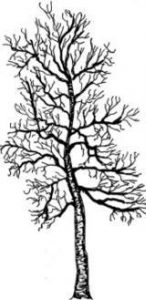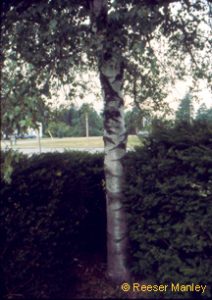Bulletin #2567, Native Trees and Shrubs for Maine Landscapes: Gray Birch (Betula populifolia)
Developed by Marjorie Peronto, Associate Extension Professor, University of Maine Cooperative Extension; and Reeser C. Manley, Assistant Professor of Horticulture, University of Maine.
For information about UMaine Extension programs and resources, visit extension.umaine.edu.
Find more of our publications and books at extension.umaine.edu/publications/.
Go native!
This series of publications is the result of a five-year research project that evaluated the adaptability of a variety of native trees and shrubs to the stresses of urban and residential landscapes in Maine. Non-native invasive plants pose a serious threat to Maine’s biodiversity. Plants such as Japanese barberry, shrubby honeysuckle, and Asiatic bittersweet, originally introduced for their ornamental features, have escaped from our landscapes, colonizing natural areas and displacing native plants and animals. By landscaping with native plants, we can create vegetation corridors that link fragmented wild areas, providing food and shelter for the native wildlife that is an integral part of our ecosystem. Your landscape choices can have an impact on the environment that goes far beyond your property lines.
Description
Form: a narrow, columnar tree with open branching
Size: 35 to 50 feet in height, 20 to 35 feet in width
Ornamental characteristics:
- smooth, chalky white bark with prominent, black, triangular patches where branches intersect the trunk clear
- yellow autumn foliage
Landscape Use
Gray birch is a pioneer tree, springing up in clear-cuts and burned areas and providing shade for emerging seedlings. It is often found growing with other pioneers such as quaking and bigtooth aspens (Populus tremuloides and P. grandidentata) and paper birch (Betula papyrifera).
As a landscape plant, gray birch offers a welcome alternative to the too frequently used paper birch. Its tolerance for many stresses, including soil compaction and drought, makes it suitable for difficult sites where other trees would fail. Among our native birches, it offers the greatest resistance to bronze birch borer and suffers only occasional leaf miner damage. ‘Whitespire’ is an exceptional cultivar with whiter bark than the species. It is especially attractive as a multi-trunk tree.
Culture

Hardiness: USDA zone 4a
Soil requirements: tolerant of a wide variety of soils
Light requirements: full sun
Stress tolerances:
soil compaction — tolerant
pollution — intolerant
deicing salts — tolerant
urban heat islands — tolerant
drought — tolerant
seasonal flooding — tolerant
Insect and disease problems: infrequent
Wildlife Value
Gray birch is host to caterpillars of several species of butterfly, including Eastern and Canadian tiger swallowtails, white admiral, mourning cloak, Compton tortoiseshell, and dreamy duskywing. Juncos, blue jays, titmice, chickadees, waxwings, and other birds eat its flower buds and seeds.
Maintenance
Irrigation: During the establishment period, defined as one year after planting for each inch of trunk diameter at planting time, water your trees regularly during the growing season. Give the root zone of each tree 1 inch of water per week; in general, a tree’s root zone extends twice as wide as its canopy. After the establishment period, provide supplemental irrigation during periods of severe drought.
Fertilization: Landscape trees and shrubs should not be fertilized unless a soil test indicates a need. Correct soil pH, if necessary, by amending the backfill soil. No nitrogen fertilizer should be added at planting or during the first growing season.
To learn more about native woody plants
Visit the Eastern Maine Native Plant Arboretum at University of Maine Cooperative Extension’s Penobscot County office, 307 Maine Avenue in Bangor. Established in 2004, the arboretum displays 24 different native tree and shrub species that can be used in managed landscapes.
Reviewed by Cathy Neal, Extension professor, University of New Hampshire Cooperative Extension.
Photos by Reeser C. Manley.
Illustration by Margery Read, Extension Master Gardener.
This series of publications and the associated research were made possible in part by the Maine Forest Service’s Project Canopy.
Information in this publication is provided purely for educational purposes. No responsibility is assumed for any problems associated with the use of products or services mentioned. No endorsement of products or companies is intended, nor is criticism of unnamed products or companies implied.
© 2008
Call 800.287.0274 (in Maine), or 207.581.3188, for information on publications and program offerings from University of Maine Cooperative Extension, or visit extension.umaine.edu.
In complying with the letter and spirit of applicable laws and pursuing its own goals of diversity, the University of Maine System does not discriminate on the grounds of race, color, religion, sex, sexual orientation, transgender status, gender, gender identity or expression, ethnicity, national origin, citizenship status, familial status, ancestry, age, disability physical or mental, genetic information, or veterans or military status in employment, education, and all other programs and activities. The University provides reasonable accommodations to qualified individuals with disabilities upon request. The following person has been designated to handle inquiries regarding non-discrimination policies: Director of Equal Opportunity and Title IX Services, 5713 Chadbourne Hall, Room 412, University of Maine, Orono, ME 04469-5713, 207.581.1226, TTY 711 (Maine Relay System).



